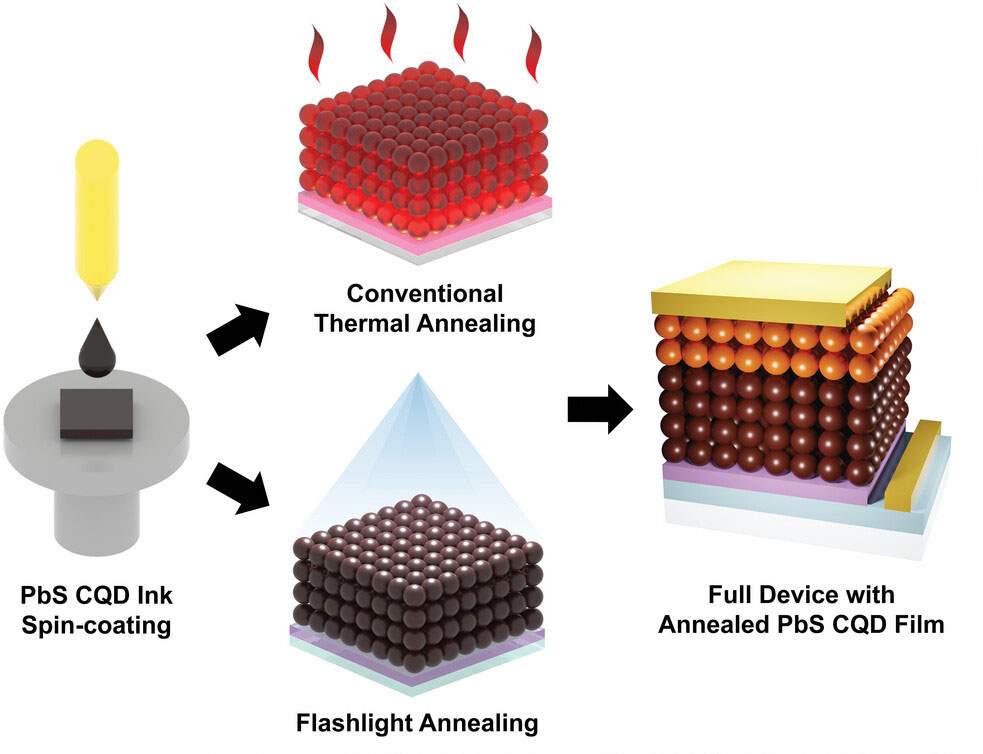| May 20, 2024 |
Quantum dot solar cells boosted by instant light treatment
(Nanowerk News) A team led by Professor Jongmin Choi of the Department of Energy Science and Engineering at DGIST has developed a PbS quantum dot that can rapidly enhance the electrical conductivity of solar cells. This was a joint research with Professor Changyong Lim of the Department of Energy Chemical Engineering at the Kyungpook National University and Professor Jongchul Lim of the Department of Energy Engineering at the Chungnam National University.
|
|
The team identified a method to enhance electrical conductivity through the use of pulse-shaped light, which generates substantial energy in a concentrated manner at regular intervals. This method could replace the heat treatment process, which requires a significant amount of time to achieve the same result. This approach is expected to facilitate the production and commercialization of PbS quantum dot solar cells in the future.
|
|
The research results have been published in Small ("Suppression of Thermally Induced Surface Traps in Colloidal Quantum Dot Solids via Ultrafast Pulsed Light").
|
 |
| Schematic illustration of the PbS colloidal quantum dot film fabrication and annealing processes. The right illustration is the structure of a whole colloidal quantum dot solar cell device comprising layers of glass, ITO, ZnO, PbS-halide, PbS-EDT, and Au (from bottom to top). (Image: Adapted from DOI:10.1002/smll.202400380 with permission by Wiley-VCH Verlag)
|
|
PbS quantum dots are nanoscale semiconductor materials that are being actively researched for the development of next-generation solar cells. They can absorb a wide range of wavelengths of sunlight, including ultraviolet, visible light, near-infrared, and shortwave infrared, and have low processing costs because of solution processing and excellent photoelectric properties.
|
|
The fabrication of PbS quantum dot solar cells involves several process steps. Until recently, the heat treatment process was considered an essential step as it effectively coats a layer of quantum dots onto a substrate and heat-treats the material to further increase its electrical conductivity.
|
|
However, when PbS quantum dots are exposed to light, heat, and moisture, the formation regarding defects on their surface can be accelerated, leading to charge recombination and deterioration of device performance. This phenomenon makes it challenging to commercialize these materials.
|
|
To suppress the formation of defects on the surface of PbS quantum dots, a team led by Professor Jongmin Choi proposed a heat treatment involving the exposure of the dots to light for a brief period of a few milliseconds.
|
|
Conventional techniques for heat-treating PbS quantum dot layers involve heating them for tens of minutes at high temperatures using hot plates, ovens, etc. The research team's proposed “pulse-type heat treatment technique” overcomes the shortcomings of the existing method by using strong light to complete the heat treatment process in a few milliseconds. This results in the suppression of surface defects and the extension of the traveling life of charges (electrons, holes) that generate electric current. Furthermore, it achieves high efficiency.
|
|
“Through this research, we were able to improve the efficiency of solar cells by developing a new heat treatment process that can overcome the limitations of the existing quantum dot heat treatment process,” said Professor Jongmin Choi of the Department of Energy Science and Engineering at DGIST.
|
|
”Furthermore, the development of a quantum dot process with excellent ripple effect is expected to facilitate the widespread application of this technology to a range of optoelectronic devices in the future,” he added.
|

